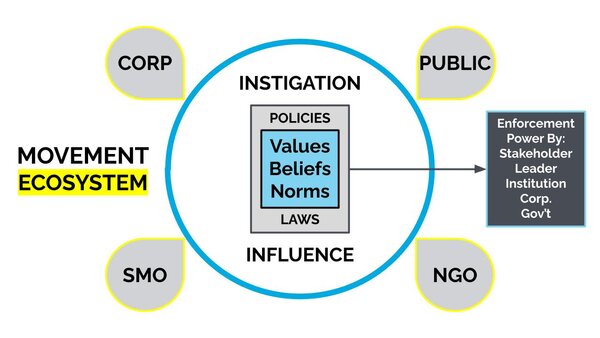The right players exerting the right pressure at the right time

“Can you plainly and simply describe what makes social change movements successful?”
The group of colleagues and fellow researchers who generated this question normally would point me to a deep examination of theoretical approaches. I can spend days talking about milestones related to a systems change approach. But this time, they wanted a straightforward, concise explanation that they could take away to share and apply in their own work.
So I gave them one, as follows:
Convergence
For social change movements to be successful, the right pressure from the right players must converge at the right time to create a moment that the institution or powerholder can’t ignore.
“Is it really that easy?” someone asked. Yes, but you must look out for the pitfalls along the way that too many organizations, nonprofits/NGOs, and even corporations fall into that make social movement progress look impossible.
The right players
Let’s begin with the question of whether the right players are involved. The social movement organizations (SMOs), nongovernmental organizations (NGOs), and corporations involved in creating campaigns for an issue must be perceived as having earned the right to do so. Without it, their pressure campaigns won’t yield enough leverage to make an institutional power player pay attention.
The right players are those willing to take a public stand and showcase authentic reasons for doing so. For a pressure campaign to have any influence, both the entities in power and the public must believe that the players’ efforts are genuine. Pressure from players viewed as simply jumping on the “bandwagon” will not engage the long-term interests, time commitment, or financial resources required to create change.
The right pressure
The right pressure involves the right target: those who hold power.
Identifying the right target is key to a pressure campaign’s success, yet it is commonly overlooked. The real power is with the entity that holds the enforcement, leverage, and ability to change policy, culture, or deeply held beliefs on an issue.
Pressure comes in the form of demands and milestones that are based on a clear understanding of what progress looks like. While stunts, media events, and other public-facing or external attention-getting activities or overly aggressive demands are tempting, the goal is to make sure that those who hold power learn what progress looks like—as defined by the movement and reinforced by its constituency. This means meeting realistic expectations of both sides: those seeking change and those holding power.
The right time
In his Movement Action Plan, Bill Moyer talks about “triggering moments,” when a grievance or challenge to those affected by an issue is broadly seen, heard, validated, and expressed externally. Triggering moments are critical opportunities for those seeking to apply pressure to create change.
To leverage a triggering moment, you must be prepared to make precise demands and call for immediate, actionable steps to advance change. Opposition to these demands will likely be at its weakest, but new narratives will begin to form as soon as entities decide what immediate changes are necessary. At the same time, those who are opposed to change will use this opportunity to sway public opinion and take new approaches to recruit and build up their supporter base. If the powerholders succeed in changing the narrative, it often is because those who were applying pressure weren’t aware of the general public’s deeply held beliefs about the issue.
At this point, coordinated and collaborative efforts are essential. All major players within the issue ecosystem need to apply pressure simultaneously with agreed-upon demands. Confusion, lack of clarity, and ineffective communication will help the powerholder and opposition easily capture and manage the narrative and counter the pressure campaigns for change.
The approaches to social change taken by social movements, nonprofits and NGOs, corporations, and even individuals vary almost as widely as the entities themselves. At their most basic level, change occurs only when those who have earned the right to push for change actually do so with the right type and amount of pressure or influence, aimed at the right targets, at the right time.
Derrick Feldmann (@derrickfeldmann) is the founder of the Millennial Impact Project, lead researcher at Cause & Social Influence, and the author of The Corporate Social Mind. See Derrick’s related articles in Philanthropy News Digest, “Nurturing a community for the greatest impact” and “Creating symbiosis between marketing and advocacy.” He also is managing director, Ad Council Research Institute and the Ad Council Edge Strategic Consultancy.






